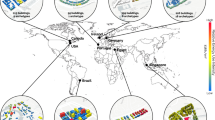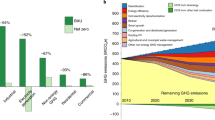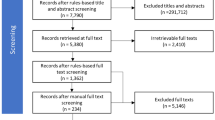Abstract
Reducing greenhouse gas emissions to avert potentially disastrous global climate change requires substantial redevelopment of infrastructure systems1,2,3,4. Cities are recognized as key actors for leading such climate change mitigation efforts6,7,8,9,10. We have studied the greenhouse gas inventories and underlying characteristics of 22 global cities. These cities differ in terms of their climates, income, levels of industrial activity, urban form and existing carbon intensity of electricity supply. Here we show how these differences in city characteristics lead to wide variations in the type of strategies that can be used for reducing emissions. Cities experiencing greater than ∼1,500 heating degree days (below an 18 °C base), for example, will review building construction and retrofitting for cold climates. Electrification of infrastructure technologies is effective for cities where the carbon intensity of the grid is lower than ∼600 tCO2e GWh−1; whereas transportation strategies will differ between low urban density (<∼6,000 persons km−2) and high urban density (>∼6,000 persons km−2) cities. As nation states negotiate targets and develop policies for reducing greenhouse gas emissions, attention to the specific characteristics of their cities will broaden and improve their suite of options. Beyond carbon pricing, markets and taxation, governments may develop policies and target spending towards low-carbon urban infrastructure.
This is a preview of subscription content, access via your institution
Access options
Subscribe to this journal
Receive 12 print issues and online access
$209.00 per year
only $17.42 per issue
Buy this article
- Purchase on Springer Link
- Instant access to full article PDF
Prices may be subject to local taxes which are calculated during checkout




Similar content being viewed by others
References
IPCC, WGI—Climate Change 2013: The Physical Science Basis (IPCC, (2013).
Jacobson, M. Z. & Delucchi, M. A. Providing all global energy with wind, water, and solar power. Part I: Technologies, energy resources, quantities and areas of infrastructure, and materials. Energy Policy 39, 1154–1169 (2011).
IEA, Energy Technology Perspectives (OECD, 2012).
Kennedy, C. A. & Corfee-Morlot, J. Past performance and future needs for low-carbon, climate-resilient infrastructure—An investment perspective. Energy Policy 59, 773–783 (2013).
Corfee-Morlot, J. et al. Cities, Climate Change and Multilevel Governance, OECD Environmental Working Papers No 14 (OECD, 2009).
Bulkeley, H. Cities and the governing of climate change. Annu. Rev. Environ. Res. 35, 229–253 (2010).
Hoornweg, D., Bhada, P., Freire, M., Trejos, C. L. & Sugar, L. Cities and Climate Change: An Urgent Agenda (World Bank, 2010).
Hoornweg, D., Sugar, L. & Trejos-Gomez, C. L. Cities and greenhouse gas emissions: Moving forward. Environ. Urban. 23, 207–227 (2011).
Arup and C40 Cities, Climate Action in Megacities: C40 Cities Baseline and Opportunities. Version 1.0 (Arup and C40, 2011).
UN-Habitat, Cities and Climate Change: Global Report on Human Settlements 2011 (United Nations Human Settlements Programme, 2011).
Kennedy, C. et al. Methodology for inventorying greenhouse gas emissions from global cities. Energy Policy 37, 4828–4827 (2010).
Kennedy, C. et al. Greenhouse gas emissions from global cities. Environ. Sci. Technol. 43, 7297–7302 (2009).
Sugar, L., Kennedy, C. A. & Leman, E. Greenhouse gas emissions from Chinese cities. J. Indust. Ecol. 16, 552–563 (2012).
Sugar, L., Kennedy, C. A. & Hoornweg, D. Synergies between climate adaptation and mitigation in development: Case studies of Amman, Jakarta, and Dar es Salaam. Int. J. Climate Change Strategies and Management 5, 95–111 (2013).
Kamal-Chaoui, L. & Plouin, M. Cities and Green Growth: Case Study of the Paris/Ile-de-France Region, OECD Regional Development Working Papers, No. 2012/02 (OECD, 2012).
OECD, Cities and Green Growth: The Case of the Chicago Tri-State Metropolitan Area, OECD Regional Development Working Papers, No. 2013/06 (OECD, 2013).
Hoornweg, D. A., Campillo, G., Linders, D., Saldivar-Sali, A. N. & Sugar, L. Barcelona Urban Research Symposium Mainstreaming Urban Metabolism: Advances and challenges in city participation. (World Bank, 2012).
Dodman, D. Blaming cities for climate change? An analysis of urban greenhouse gas emissions inventories. Environ. Urban. 21, 185–201 (2009).
Hillman, T. & Ramaswami, A. Greenhouse gas emission footprints and energy use benchmarks for eight U.S. cities. Environ. Sci. Technol. 44, 1902–1910 (2010).
Sovacool, B. K. & Brown, M. A. Twelve metropolitan carbon footprints: A preliminary comparative global assessment. Energy Policy 38, 4856–4869 (2010).
Ibrahim, N., Sugar, L., Hoornweg, D. & Kennedy, C. Greenhouse gas emissions from cities: Comparison of international inventory frameworks. Local Environ. 17, 223–241 (2012).
Mohareb, E., Kennedy, C. A., Pressnail, K. & Harvey, D. Decoupling of building energy use and climate. Energy Build. 43, 2961–2963 (2011).
O’Brien, W., Kennedy, C. A., Athienitis, A. & Kesik, T. The relationship between net energy use and the urban density of solar buildings. Environ. Plann. B 37, 1002–1021 (2010).
Kennedy, C. A., Demoullin, S. & Mohareb, E. Cities reducing their greenhouse gas emissions. Energy Policy 49, 774–777 (2012).
Kikuchi, E., Bristow, D. & Kennedy, C. A. Evaluation of region-specific residential energy systems for GHG reductions: Case studies in Canadian cities. Energy Policy 37, 1257–1266 (2009).
MacPherson, N. D., Keoleian, G. A. & Kelly, J. C. Fuel economy and greenhouse gas emissions labeling for plug-in hybrid vehicles from a life cycle perspective. J. Indust. Ecol. 16, 761–773 (2012).
Hawkins, T. R., Singh, B., Majeau-Bettez, G. & Strømman, A. H. Comparative environmental life cycle assessment of conventional and electric vehicles. J. Indust. Ecol. 17, 53–64 (2013).
Hoornweg, D. & Freire, M. Building Sustainability in an Urbanizing World: A Partnership Report Appendix 10 (World Bank, 2013).
Acknowledgements
This research was supported by the Natural Sciences and Engineering Research Council of Canada.
Author information
Authors and Affiliations
Contributions
C.A.K., N.I. and D.H. co-wrote the paper; C.A.K. and N.I. conducted the analysis.
Corresponding author
Ethics declarations
Competing interests
The authors declare no competing financial interests.
Supplementary information
Rights and permissions
About this article
Cite this article
Kennedy, C., Ibrahim, N. & Hoornweg, D. Low-carbon infrastructure strategies for cities. Nature Clim Change 4, 343–346 (2014). https://doi.org/10.1038/nclimate2160
Received:
Accepted:
Published:
Issue Date:
DOI: https://doi.org/10.1038/nclimate2160
This article is cited by
-
How does internet development affect urban eco-resilience: evidence from China
Economic Change and Restructuring (2024)
-
Environmental and welfare gains via urban transport policy portfolios across 120 cities
Nature Sustainability (2023)
-
Mapping and evaluating sustainable and unsustainable urban areas for ecological management towards achieving low-carbon city: an empirical study of Asir Region, Saudi Arabia
Environmental Science and Pollution Research (2023)
-
Investigation on the uncertainty analysis of heat meters with a novel method of integral calibration
Journal of Thermal Analysis and Calorimetry (2023)
-
Toward the attainment of climate-smart PPP infrastructure projects: a critical review and recommendations
Environment, Development and Sustainability (2023)



